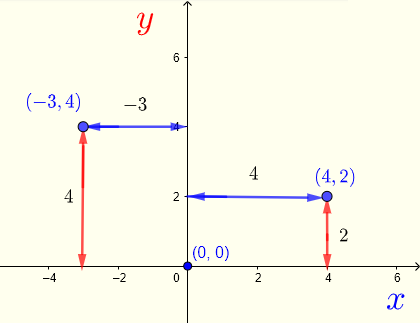


Example 1
Plot the given points given by their polar coordinates.
a) \( (2,0) \) b) \( (2,\dfrac{3\pi}{4}) \) c) \( (4,\dfrac{7\pi}{3}) \) d) \( (3,-\dfrac{5\pi}{4}) \)
Solution to Example 1
The points given by their polar coordinates are plotted below.

For example, the coordinates \( (r,\theta) \), \( (r,\theta + 2\pi) \), \( (r,\theta - 4\pi) \)... represent the same point.
The above definition may be extended to use signed distances and allow the radial coordinate \( r \) to be negative such that the points \( (- r , \theta) \) and \( (r , \theta) \) are on the same line through the pole, at the same distance \( |r| \) from the pole such that point \( r , \theta \) is in the same quadrant as \( \theta \) and the point \( - r , \theta \) is in the opposite quadrant as that of \( \theta \).
The two points corresponding to \( (- r , \theta) \) and \( (r , \theta) \) are reflection of each other with respect to the pole (origin) and therefore we may say that the polar \( (- r , \theta) \) and \( (r , \theta + \pi) \) represent the same point.
Example 2
Plot the pairs of points given by their polar coordinates.
a) \( (-2,0) \) and \( (2,0) \) b) \( (-2,\dfrac{3\pi}{4}) \) and \( (2,\dfrac{3\pi}{4}) \) c) \( (-4,\dfrac{-\pi}{3}) \) and \( (4,\dfrac{-\pi}{3}) \)
Solution to Example 2
The pair of points given by their polar coordinates with negative and positive radial distance \( r \) are plotted below.

One of the major differences between Cartesian and polar coordinates is that polar coordinates of the same point may be written in an infinite number of ways.
For any integer \( n \) and any other integer \( k \), all coordinates of the form \( (r,\theta) \), \( (r,\theta+2n\pi) \) and \( ( - r,\theta+(2k+1) \pi) \) represent the same point.
Example 3
Show that all the given polar coordinates represent the same point.
a) \( (2,-\dfrac{5\pi}{4}) \) b) \( (-2,-\dfrac{\pi}{4}) \) c) \( (2,\dfrac{3\pi}{4}) \) d) \( (2,\dfrac{19\pi}{4}) \)
e) \( (2,-\dfrac{13\pi}{4}) \)
Solution to Example 3
We rewrite the given polar coordinates so that they have the equal radial coordinate \( r \) and equal angular coordinate \( \theta \) such that \( 0 \le \theta \lt 2 \pi\)
a)
The angular coordinate \( -\dfrac{5\pi}{4} \) is in the range \( [-2\pi , 0] \), hence add \( 2 \pi \) to it.
\( -\dfrac{5\pi}{4} + 2 \pi = \dfrac{3\pi}{4} \)
Hence the given coordinates \( (2,-\dfrac{5\pi}{4}) \) and \( (2, \dfrac{3\pi}{4}) \) represent the same point.
b)
Change the polar coordinates so that it has a positive \( r \) by adding \( \pi \) to the angular coordinate
\( (-2,-\dfrac{\pi}{4}) \) and \( (2,-\dfrac{\pi}{4}+\pi) = (2,\dfrac{3\pi}{4}) \) represent the same point
c)
It has equal \( r = 2 \) and \( \dfrac{3\pi}{4} \) so no change is required
d)
The angular coordinate is in the range \( [4\pi , 5\pi] \); hence subtract \( 4 \pi \) from the angular coordinate of the given point \( (2,\dfrac{19\pi}{4}) \)
\( \dfrac{19\pi}{4} - 4\pi = \dfrac{3\pi}{4} \)
Hence \( (2,\dfrac{19\pi}{4}) \) and \( (2,\dfrac{3\pi}{4}) \) represent the same point.
e)
The angular coordinate is in the range \( [ -4\pi , -3\pi] \) , hence add \( 4 \pi \) to the angular coordinate of the given point \( (2,-\dfrac{13\pi}{4}) \)
\( -\dfrac{13\pi}{4} + 4 \pi = \dfrac{3\pi}{4} \)
Hence \( (2,-\dfrac{13\pi}{4}) \) and \( (2,\dfrac{3\pi}{4}) \) represent the same point.
All the given polar coordinates represent the same point \( (2,\dfrac{3\pi}{4}) \).
The same point \( P \) may be located using Cartesian or polar coordinates. The relationship between the two sets of coordinates may be found using trigonometry in a right triangle.
\( x = r \cos \theta \) and \( y = r \sin \theta \)
\( r^2 = x^2 + y^2 \) and \( \theta = \arctan (\dfrac{y}{x}) \)

Polar equations are of the form \( f(r,\theta) = 0 \) and their graphs are all the set of points \( (r,\theta) \) that are solution to the equation.
Example 4
Sketch the graph of the polar equation \( r - 3 \sin \theta = 0\) .
Solution to Example 4
Solve the given equation for \( r \).
\( r = 3 \sin \theta \)
Make a table of values
| \( \theta \) | \( r = 3 \sin \theta\) |
|---|---|
| \( 0 \) | \( 0 \) |
| \( \pi/6 \) | \( 3/2 \) |
| \( \pi/4 \) | \( 3/\sqrt 2 \) |
| \( \pi/3 \) | \( 3 \sqrt 3 /2 \) |
| \( \pi/2 \) | \( 3 \) |
| \( 2\pi/3 \) | \( 3 \sqrt 3 /2 \) |
| \( 3\pi/4 \) | \( 3/\sqrt 2 \) |
| \( 5\pi/6 \) | \( 3 / 2 \) |
| \( \pi \) | \( 0 \) |
